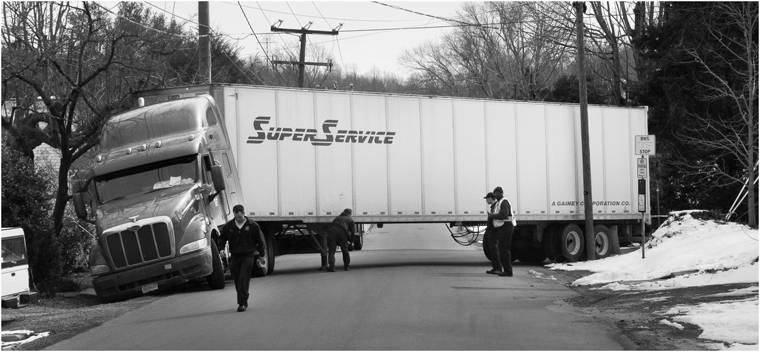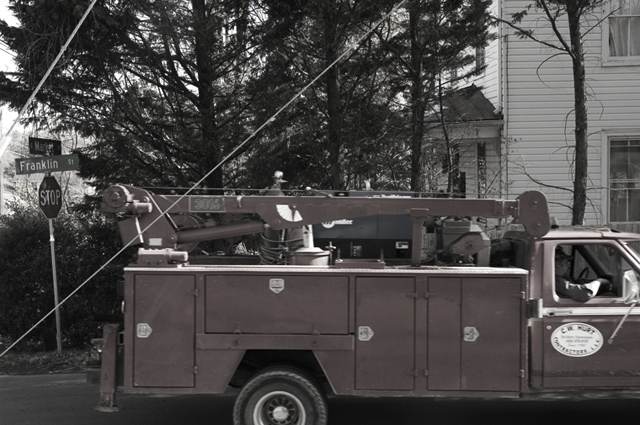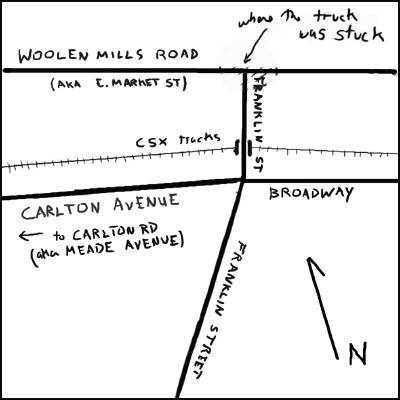picture v 1000 words

38 01.433N 78 27.678W Intersection of Franklin and Market
Long ago a good man lived on the hill that stands over the Woolen Mills neighborhood. Post-war was a troubled time. People were hungry, there was little currency circulating, the local economy was in ruins.The good man came to a realization which he stated formally February 11, 1881:
"The property of a manufacturing Company must ultimately rest on the efficiency and fidelity of its labor. It must be promoted by whatever promotes their self respect, elevates their character, and cultivates local attachments and the home feeling."
Mr. Marchant was a good man. He provided the people of the Mill Village with jobs, affordable housing and health care. He provided food and fuel at reasonable prices. He built a community.
Vestiges of the "local attachment and the home feeling" that Marchant imbued in this village are extant 96 years after his death.
Modern pressures are afoot as well. On the menu today, Traffic.
A neighborhood elder relates that it was once a notable event when a car came this far east on Market Street. The street dead-ends at the Rivanna River and the Mill. Alas, that was before Mapquest and traffic signals.
Today the Market-Franklin Street path offers a fabulous shortcut for traffic looking to transverse the southeast quadrant of Charlottesville without encountering pesky stoplights.
The Woolen Mills is a residential neighborhood. Narrow streets. Houses built up close to the road before the invention of the internal combustion engine.

Suck it up. When there is a shortcut, nothing else matters.
And so they come. Vegetable, animal, mineral. The feces haulers, cattle trailers, sixty-six thousand pound concrete trucks, construction workers, sewage authority folk, garage door installers, the auto parts jobbers, the breadmen, the Developer's men: without name, without number without end they shortcut through this neighborhood.
Once upon a time I collected signatures from residents on Market Street who endure the daily flow. Everyone signed.
Incessant cut-through traffic is destroying the fabric of this neighborhood.
Yesterday a hapless out of state truck driver attempted to navigate his 18 wheeler through the Mill Village. He was lost. Trying to pick up a load of scrap metal nearby. There are no signs posted on Franklin Street saying anything like:
TRUCKS LARGER THAN 2 AXLES- NO PASSAGE
or
NO COMMERCIAL VEHICLES
or
NO COMMERCIAL VEHICLES
So, he came on.
He successfully threaded his way under the CSX tracks. He made a complete stop at the intersection of Franklin and Market, but he was unable to negotiate the turn. As he attempted to head west on Market the rear end of his trailer lodged against a utility pole, the front end of his truck got stuck in the ditch on the north side of Market.

With the neighborhood cut-through blocked, drivers made their way to points west via Carlton Avenue (a road whose frontage is largely zoned for manufacturing and business use).
Currently the City doesn't have a traffic engineer on payroll. It would be helpful to fill this position.
Are you a traffic engineer? Please contact the Charlottesville Department of Human Resources and apply now! Hiring Salary Range $37,606.40 to $55,053.19 per year.
Tell them you'd like to help save a historic neighborhood.
Labels: government, motoring, neighborhood

4 Comments:
Thanks Bill. Nicely written rant bringing our attention to an issue of importance for our neighborhood. Well done! Mike M
Also important to point out how much more freight traffic is no handled by track as opposed to rail, and the deleterious effect this has had from an environmental standpoint - on a variety of levels.
Well-done.
- Barrett
If I moved into an urban neighborhood named after an industrial activity, I would find it surprising NOT to have a lot of commercial traffic.
Dear Anon-
The Woolen Mill was in operation 56 years before management found it expedient to purchase a gasoline powered vehicle to transport their cloth.
Well designed Industry does not have to be a disaster to the surrounding neighborhood.
The Woolen Mills neighborhood had a track record of being a garden in a bend of the river, cradled by the Southwest Mountains. That is what makes the n'hood historically unique. It was an evolutionary oddity, a harmonious productive blend of Southern Agrarian and Industrial forms.
Please, if you choose to post anonymously, feel free to sign your name.
Thanks,
Bill Emory
emory@billemory.com
Post a Comment
<< Home